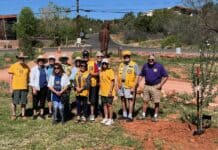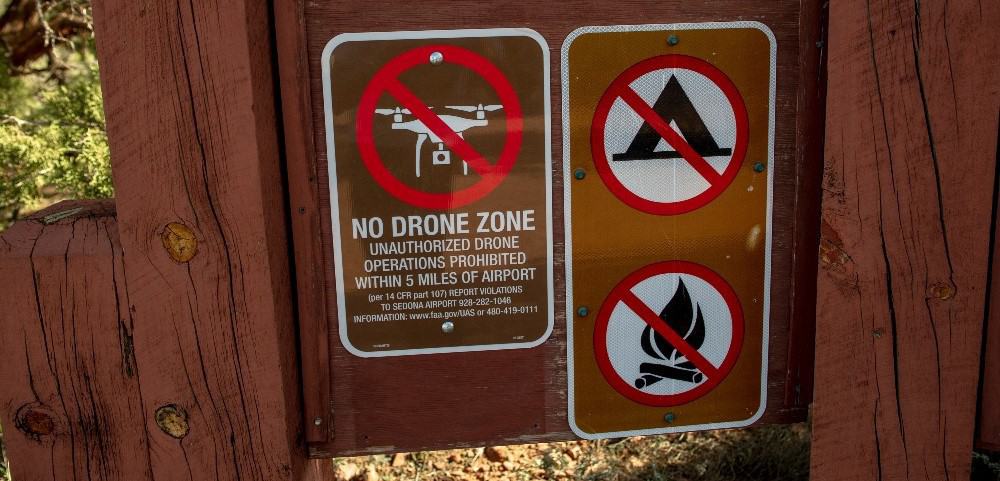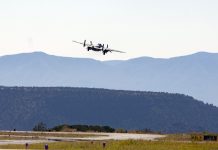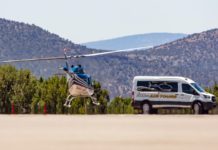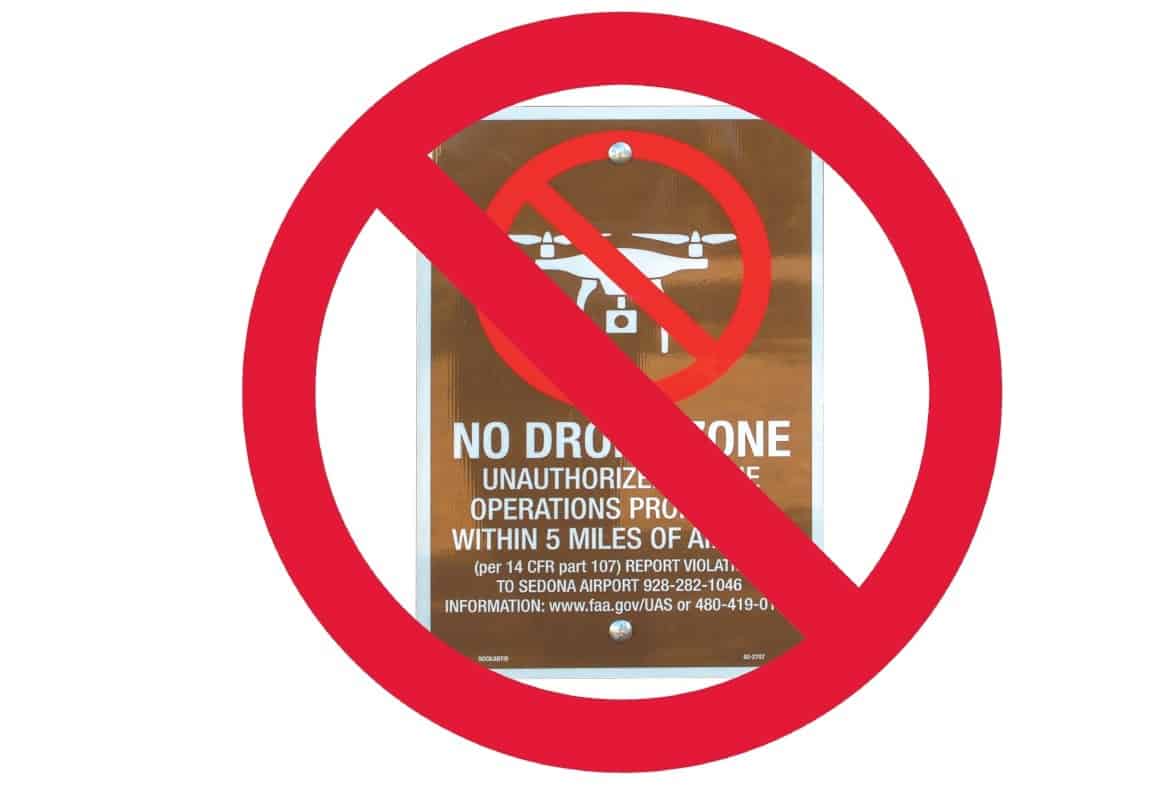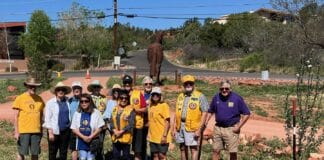Drones are small remote-controlled flying machines often used by hobbyists for aerial photography, and reconnaissance in firefighting and law enforcement. Sedona has become a destination for recreational drone users due to the scenic geography. But drone enthusiasts have noticed the dozens of “No Drone Zone” signs posted at trailheads and parks around the red rock area.
These signs describe the areas as “No Drone Zones,” despite the fact that no federal law prohibits drones from operating in the air.
Sedona Oak Creek Airport Authority management and U.S. Forest Service personnel claim drones are not permitted or require special authorization from the Sedona Airport. However, neither the USFS, nor municipal, county or airport governments have the legal authority to regulate airspace — that power is strictly reserved to the Federal Aviation Administration.
FAA Pacific Division Communications Manager Ian Gregor stated, “It’s important to note that the FAA has sole jurisdiction over the nation’s airspace, including airspace immediately around airports, for the purposes of air navigation. Airport operators cannot ban drones.”
The FAA’s Pacific Division includes California, Arizona, Nevada, Hawaii and the Pacific islands. According to FAA classifications, these trail areas are not “no drone zones” — they actually offer some of the most favorable regulatory conditions for drones under Class G Uncontrolled Airspace.
According to Title 14 of the Code of Federal Regulations, Part 107, drone users with a Remote Pilot Certification can operate a drone freely below 400 feet in Class G Uncontrolled Airspace, but must obtain an FAA waiver to fly at higher altitudes.
Recreational — non-certified or non-commercial — drone users, are required to notify the airport when flying within 5 miles of its runway — but only if there is an air traffic control tower.
The Sedona Airport does not have an air traffic control tower, therefore, no notification is required. FAA Aviation Safety Inspector Jeffrey Larson confirmed that the location of the signs is Class G Uncontrolled Airspace and that no notification for drone flights is required, meaning these are not “no drone zones,” despite the misleading signs.
“It’s important to note that the FAA has sole jurisdiction over the nation’s airspace, including airspace immediately around airports, for the purposes of air navigation. Airport operators cannot ban drones.”
Ian Gregor
Pacific Division Communications Manager,
Federal Aviation Administration
Reports Unenforceable
The “No Drone Zone” signs say to “Report Violations” and then list a number, which connects to airport staff. The Sedona Red Rock News called the number and found that complaints are forwarded to the Sedona Airport Manager Deborah Abingdon.

The other number listed on the signs directs callers to the regional FAA switchboard in Scottsdale. Abingdon referenced a “No Drone Zone” map being circulated by airport officials and posted on the Coconino National Forest website.
Abingdon repeated the position stated on the airport website that “The Sedona Oak Creek Airport Authority does not recommend nor condone operations within the 5-mile radius of the Sedona Airport.”
She stated that many drone pilots “are not filing [with the airport].”
But no such filing requirement exists.
Abingdon stated the airport “does not recommend” drone flights, but did not state they were legally prohibited under any law. Abingdon said her concerns are in the interest of flight safety. She said an incident with a drone allegedly occurred when “one of our local pilots was flying his small single engine airplane in the vicinity of the airport when it was struck by a drone. The aircraft landed safely, but had major damage to the propeller. The aircraft was grounded for 30 days so that the FAA could investigate the incident.”
According to an Aero News Net article published April 26, 2017, “A pilot flying near Sedona reported that a drone collided with his airplane in mid-air, but the FAA says that it can’t find any evidence of the incident.”
According to that story, former Sedona Airport General Manager Amanda Shankland told television station KSAZ a drone was destroyed and the plane’s propeller was damaged, but the story concluded “The FAA, however, said that its investigation of the incident came to a different conclusion. ‘Multiple FAA inspectors examined the evidence and found no indication of an in-flight collision with any object.’”
Despite requests, Abingdon did not provide the date of the alleged incident, nor the FAA incident report number, nor the name of the pilot, nor the type of aircraft involved.
When pressed further, Abingdon still did not provide the name of the pilot, date nor details, stating, “The owner of this aircraft was not given a report,” raising questions about whether this incident ever occurred.
 No report of any collision in Sedona airspace appears on the National Transportation Safety Board’s Aviation Accident Database in 2017.
No report of any collision in Sedona airspace appears on the National Transportation Safety Board’s Aviation Accident Database in 2017.
The dozens of “no drones zone” signs appear to carry no penalty.
Reports of drone activity forwarded to the numbers listed on those signs will result in no action because the drone users being reported are not violating any law or regulation.
Michael Dearden, a staff member at the Sedona airport, said that several calls reporting drones are received every week — complaints which he said are forwarded to airport manager Abingdon.
Yet Abingdon stated, “I do not get many phone calls [regarding drones].”
Signs Posted Despite Law
According to Adam Barnett, Red Rock Ranger District recreation program manager, the “no drone zone” signs indicate that “Unauthorized drone use in this area is prohibited” and were installed “at the request of the Sedona Oak Creek Airport Authority in early 2017, in order to comply with new FAA regulations.”
However, no regulations prohibiting drones in this airspace existed in 2017, nor do they exist now.
The signs cite “14 CFR Part 107,” however, the FAA’s fact sheet about Part 107 explicitly states, “Operations in Class G airspace are allowed without ATC permission.”
Despite requests, Abingdon did not provide any other law that might ban drones, nor did she state when the erroneous signs would be changed or removed from Sedona area trailheads.
Drones Can Fly
Drones, officially known as Unmanned Aircraft Systems, are treated as aircraft under U.S. law, but they fly with fewer regulations than manned craft. FAA oversees drone activity and penalizes those who misuse the airborne craft.
 According to Freedom of Information Act documents obtained by Motherboard, a tech news agency, dozens of people have been fined by the FAA for reckless or unauthorized drone usage. A typical citation is about $1,500. Many of the cases resulting in fines involved a drone operator flying over crowds of people, such as at sporting events.
According to Freedom of Information Act documents obtained by Motherboard, a tech news agency, dozens of people have been fined by the FAA for reckless or unauthorized drone usage. A typical citation is about $1,500. Many of the cases resulting in fines involved a drone operator flying over crowds of people, such as at sporting events.
Other citations were issued when collisions with buildings or pedestrians occurred, or for flying in controlled airspace, such as in the Air Defense Identification Zone around Washington, D.C., where no drone flights are permitted at all.
Individuals or companies that don’t respect aviation law can only be reported to the FAA for investigation, but not for violations.
The Class G airspace over Sedona, however, leaves few limits on drone operators. Regarding the “no drone zone” signs on USFS land, the Coconino National Forest website states, “The U.S. Forest Service does not have the authority to establish any additional regulations regarding where UAS can or can’t be flown.”
Issues that do concern the Forest Service regarding drones are the well-being of wildlife and protecting backcountry firefighting crews. Tracking or harassing wildlife with drones can result in panic and even death of an animal, which often perceive a drone as a predator. Birds of prey frequently attack or flee from drones, perceiving them as competing raptors. They can be injured when trying to attack a drone mid-air, or may abandon nestlings where drones are active above.
Temporary Flight Restrictions are typically placed on areas around wildfires so that emergency aircraft can access a burn — another situation where drone activity would concern the U.S. Forest Service.
Other than those scenarios, USFS lands are legally open for recreational drone use.
Wilderness and primitive areas can be accessed by drone, but it’s illegal to launch, land or crash a drone in federally protected wilderness, because drones are considered “motorized vehicles” and prohibited on land by law.
Unable to Regulate
Numerous towns and federal agencies have made attempts to control, or abolish, drone traffic, often seen as an irritation or an invasion of privacy. Most of these attempts have failed.
Jonathan Rupprecht, a lawyer who specializes in drone law, wrote in an email: “The Federal Aviation Administration has been charged with integrating drones into the national airspace. That same section [of law] says, ‘A citizen of the United States has a public right of transit through the navigable airspace.’”
In regards to local statutes, or other regulations that seek to limit drone usage, Rupprecht stated, “Recently, the Federal District Court of Massachusetts struck down the local drone ordinance of the city of Newton as being in conflict with federal law, which should not have surprised anyone, since U.S. case law has ruled on similar issues decades before. “See the City of Burbank v. Lockheed Terminal case.”
Rupprecht cautions against attempts by agencies or locales to overstep their authority.
“Well-meaning entities need to be careful in trying to regulate drones, as they could potentially find themselves walking into a minefield and having a hard time getting themselves out,” he stated.
Per FAA rules, drone hobbyists and certified drone pilots should respect human privacy, the wellbeing of wildlife and refer to the FAA for specific guidance on flight restrictions.


